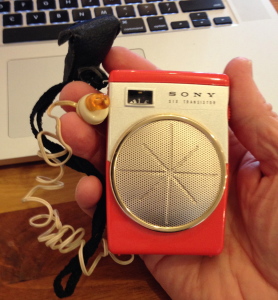My recent purge/re-org of photos was productive and satisfying. So I decided to tackle my iTunes music library next. I collected a lot of music in the 60s and 70s. LPs, reel-to-reel, cassettes. After I left radio (no longer “on the air” playing music for others to listen to) I pretty much lost interest in music until the iPod came along in 2001. But I never amassed a giant collection of songs.
As I turned my attention to my iTunes library I discovered I had 800+ titles. Scanning and sampling, it quickly became apparent that I hadn’t listened to some of these songs in years… and probably wouldn’t listen to many of them ever again. The result of ripping and entire LP that included only two or three songs that I liked. Or purchasing an entire “CD” from iTunes. But you don’t delete songs, right? You might listen to them someday. So, just tuck them away in a folder or playlist for that day.
In some manner I can’t explain, keeping those never-gonna-listen-to-them again songs were preventing me from listening to the stuff I liked. So I purged. Down to about 650 songs.
I’m still organizing. Creating playlists, adding ratings, etc. This morning I picked my 100 “favorite” songs (from the 650). Much harder than I expected and certainly a moving target. I’ll keep refining that. The goal will be, I think, to reach a point where any song that comes up in shuffle will prompt me to think/says, “Ooh. I love that song!”
I know what you’re thinking (as does The Amazing Kreskin): Why not subscribe to Spotify or Beats or one of the other streaming services and enjoy ALL the songs. See, that’t the problem for me. I can’t enjoy all the songs. Too many choices. I’m glad those services exist and hope there are more and better ones coming, but I’m gonna concentrate on really listening to and enjoying the music I have.

 “Transistors were being sold in 1954 to the military for about $16 apiece. But in order to break into the consumer marker. Haggerty insisted that his engineers find a way to make them so that they could be sold for less than $3. They did. He also developed a Jobs-like knack, which would serve him then and in the future, for conjuring up devices that consumers did not yet know they needed but would soon find indispensable. In the case of the transistor, Haggerty came up with the idea of a small pocket radio. When he tried to convince RCA and other big firms that made tabletop radios to become a partner in the venture, they pointed out (rightly) that consumers were not demanding a pocket radio. But Haggerty understood the importance of spawning new markets rather than merely chasing old ones. He convinced a small Indianapolis company that built TV antenna boosters to join forces on what would be called the Regency TR-1 radio. Haggerty made the deal in June 1954 and, typically, insisted that the device be on the market by that November. It was. The Regency radio, the size of a pack of index cards, used four transistors and sold for $49.95. It was initially marketed partly as a security item, now that the Russians had the atom bomb. “In event of an enemy attack, your Regency TR-1 wiU become one of your most valued possessions,” the first owner s manual declared. But it quickly became an object of consumer desire and teenage obsession. Its plastic case came, iPod-like, in four colors: black, ivory, Mandarin Red, and Cloud Gray. Within a year, 100,000 had been sold, making it one of the most popular new products in history.”
“Transistors were being sold in 1954 to the military for about $16 apiece. But in order to break into the consumer marker. Haggerty insisted that his engineers find a way to make them so that they could be sold for less than $3. They did. He also developed a Jobs-like knack, which would serve him then and in the future, for conjuring up devices that consumers did not yet know they needed but would soon find indispensable. In the case of the transistor, Haggerty came up with the idea of a small pocket radio. When he tried to convince RCA and other big firms that made tabletop radios to become a partner in the venture, they pointed out (rightly) that consumers were not demanding a pocket radio. But Haggerty understood the importance of spawning new markets rather than merely chasing old ones. He convinced a small Indianapolis company that built TV antenna boosters to join forces on what would be called the Regency TR-1 radio. Haggerty made the deal in June 1954 and, typically, insisted that the device be on the market by that November. It was. The Regency radio, the size of a pack of index cards, used four transistors and sold for $49.95. It was initially marketed partly as a security item, now that the Russians had the atom bomb. “In event of an enemy attack, your Regency TR-1 wiU become one of your most valued possessions,” the first owner s manual declared. But it quickly became an object of consumer desire and teenage obsession. Its plastic case came, iPod-like, in four colors: black, ivory, Mandarin Red, and Cloud Gray. Within a year, 100,000 had been sold, making it one of the most popular new products in history.”